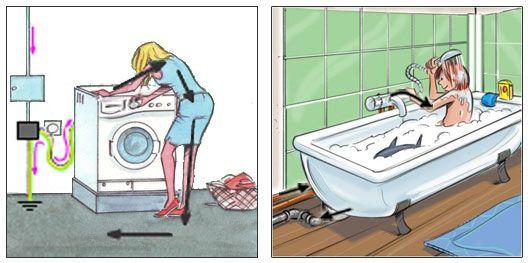Contact current is a current that runs through the body between two points of contact at different potentials (a device and the floor, a tap and the floor, a heater and the floor…) while this voltage is first of all not obvious since the connection to the voltage source is indirect (see examples in figure 1): contact current do not actually mean that there is a contact with active parts (contact with live parts, electrocution). Moreover, contact currents are neither induced currents, which are currents that can flow through the human body in relation to ambient electromagnetic fields, nor electrostatic discharges (ESD).
Contact currents

Figure 1 – Contact currents (bathtub and washing machine)
Contact currents are linked to a potential difference called “contact voltage”. Let’s illustrate this by two examples (Figure 1):
- In case of a partial degradation of the insulation of wires in an older washing machine a leakage current can occur. It is a weak current not incompatible with an apparently normal functioning of the machine. Depending on the quality of the earthing of the frame of the washing machine, the frame could be raised to a potential different from the ground: between the person touching the frame and the ground a potential difference exists, meaning that a current will flow through the person.
The current intensity flowing through the body will be low if the machine is correctly earthed and if the impedance of the person is high (namely dry hands and shoes that can partly insulate). - The bathtub situation is a little bit trickier to understand!
Metallic hoses and bathtub should be at the same potential to prevent electric shocks. It is done by connecting water pipes and/or bathtub to earth or by connecting each conducting parts with a protective wire (called equipotential bonding).
Some parts could be even so at a different slightly potential for various reasons. For example, a potential difference could arise between the water inlet hose (the tap) and the drain hose. A child in his bath, playing with the tap could be crossed by a contact current. The child being naked and wet (low impedance), the current will flow through him/her even more easily than in the example above (see also Contact currents and childhood leukaemia?).
Remarks: Hoses in PVC, less conductive, do not lead to contact voltage in the bathtub.
Contact current intensity can be weak. Very often, contact currents are not perceived (perception threshold of human being: around 0.5 mA).
For safety purposes related to electrocution risks, residential electric wirings are protected against fault currents when they exceed 300 mA (30 mA in bathrooms), meaning that up to 30 mA the differential will not break the circuit. Exceeding perception threshold will not directly trigger the circuit-breaker. Note that it would be mistaken to believe protecting our house wiring to levels lower than 30 mA because inopportune triggering would be too numerous.


